An Offer I Couldn't Refuse
I've been saying for awhile that I wouldn't do any more illustration work. That I'd just work on my next book. But a statement like that needs to be qualified. Is it still illustration when you're given completely free rein to do whatever you want? Or is that a commissioned painting? I don't know. I just know that that's my kind of illustration job, baby!
Russ Greenberg is Director (and founder) of the Smithsonian Migratory Bird Center, whose mission is to help imperiled migratory birds through study, education and activism. At least that's how I'd describe their mission. From their web site:
The Smithsonian Migratory Bird Center bridges the academic, policy-making, and public worlds to coordinate efforts to protect migratory birds and their habitats. We bring public and policy issues to bear on our research--looking both at the way human-made changes affect bird populations and the way bird habitat preservation will affect human populations--and we translate our research findings into recommendations for public and policy action.
From the start, Russ has asked me to illustrate SMBC materials, from pamphlets to books to posters to Auk covers to booth displays. I've done pencil drawings, scratchboards, and paintings, and I've enjoyed every minute of it. Russ is ridiculously easy to work with and very appreciative of my efforts.
Here's how some of my watercolors were used for a booth display promoting shade-grown coffee:
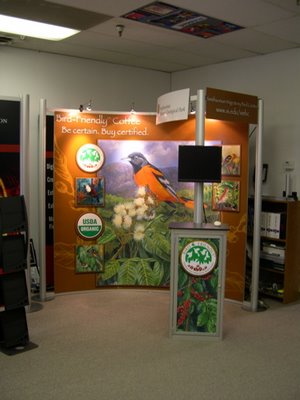 The original oriole painting is a half-sheet of watercolor paper, maybe 11 x 16". I couldn't have imagined that, blown up to 8 FEET tall, it would look this good. I have to give due credit to designer Clayton Tompkins here. It's an inspired design. I would like Clayton to design my next kitchen, or house.
The original oriole painting is a half-sheet of watercolor paper, maybe 11 x 16". I couldn't have imagined that, blown up to 8 FEET tall, it would look this good. I have to give due credit to designer Clayton Tompkins here. It's an inspired design. I would like Clayton to design my next kitchen, or house.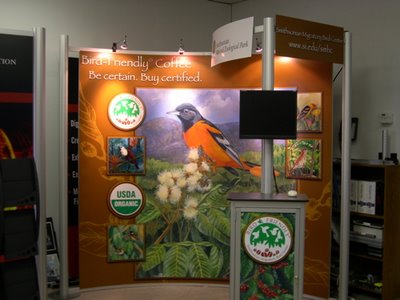 I love everything about this booth. Russ says people just flock to it, because it's so visually appealing. And what a good cause--promoting shade-grown fair-trade coffee, which is good for coffee workers, coffee drinkers, and migratory birds, who love the habitat shade-grown plantations provide.
I love everything about this booth. Russ says people just flock to it, because it's so visually appealing. And what a good cause--promoting shade-grown fair-trade coffee, which is good for coffee workers, coffee drinkers, and migratory birds, who love the habitat shade-grown plantations provide.So when Russ e-mailed to ask if I'd be interested in doing a painting for SMBC's trade show booth, I listened. Here were the guidelines he laid out:
SMBC is doing a fancy new booth for all of the events and festivals we perform at. I know this is a total long shot. But is there any chance we can commission you for a painting for this? We want something that is face-melting in its beauty and captures the essence of what we are about. You are the one to do this, if you aren't totally booked...
He had me from "face-melting." Wait. Is this really work? To be asked to create something beautiful depicting birds, with no strictures on which birds or what the setting will be?
So I started thinking about migratory birds. It seemed only natural that the birds would be in flight. Up in the sky. So, having been completely enthralled with the skyscapes this autumn, I decided to put the birds against some really cool-looking clouds--my favorite--thunderheads against a blue sky.
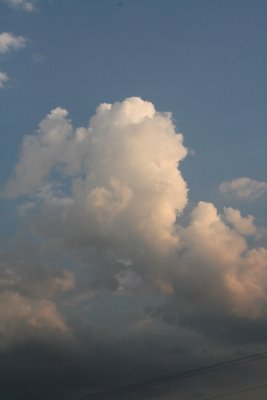 Yaaahh! Watercolor is just the medium to do that. Nothing like it for cirrus and billowing cloudbits, active sky washes and crisp edges.
Yaaahh! Watercolor is just the medium to do that. Nothing like it for cirrus and billowing cloudbits, active sky washes and crisp edges.I started taking pictures of every arresting cloudscape I saw. There were some doozies on the way to Ashland in September 07. You just can't get clouds like that in the winter. What a treat, to be able to paint something I love looking at so much.
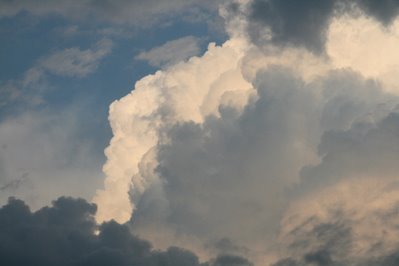 What birds to paint? It was wide open. I decided on a suite of birds which are imperiled, for many different reasons. Whether it be habitat loss on the wintering ground, habitat loss on the breeding ground, pesticide spraying in the boreal forests, clearcutting, destruction of food base, or loss of nesting sites, these birds are all in some kind of trouble. Bobolink seemed an emblematic grassland species, losing habitat faster than almost any species. Bay-breasted warblers are being hammered on the breeding grounds by pesticide spraying of spruce forests. Ruddy turnstones are having their migration food base (the eggs of horseshoe crabs) "harvested" right out from under them. And so it goes.
What birds to paint? It was wide open. I decided on a suite of birds which are imperiled, for many different reasons. Whether it be habitat loss on the wintering ground, habitat loss on the breeding ground, pesticide spraying in the boreal forests, clearcutting, destruction of food base, or loss of nesting sites, these birds are all in some kind of trouble. Bobolink seemed an emblematic grassland species, losing habitat faster than almost any species. Bay-breasted warblers are being hammered on the breeding grounds by pesticide spraying of spruce forests. Ruddy turnstones are having their migration food base (the eggs of horseshoe crabs) "harvested" right out from under them. And so it goes.And then there was beauty. And the thrill of painting a hooded warbler next to a ruddy turnstone, a bobolink next to a scissor-tailed flycatcher. It didn't have to make any real sense; it's an allegory for beauty and courage in the face of peril. Such a delight to compose. I spent several days in the composition phase, always the most time-consuming. I had to draw the birds, make sure they were in scale to each other, and arrange them in a pleasing composition. Here's the first draft, just a bunch of paper birds taped together, shot on my sidewalk.
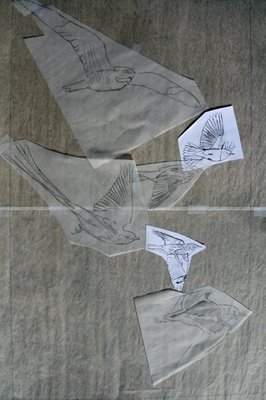 One of the problems that arises when you're painting birds of widely disparate sizes next to each other is that of scale. If you've got a warbler next to a nighthawk, you've got to make sure the nighthawk isn't too big to paint comfortably, and the warbler isn't too small to paint comfortably. So, to get the warbler big enough so that I can see the detail, I've got to paint it about life size. And the nighthawk gets proportionately bigger. And before you know it, I've got a painting that's 21 x 30", a full sheet of watercolor paper, and that's a BIG watercolor.
One of the problems that arises when you're painting birds of widely disparate sizes next to each other is that of scale. If you've got a warbler next to a nighthawk, you've got to make sure the nighthawk isn't too big to paint comfortably, and the warbler isn't too small to paint comfortably. So, to get the warbler big enough so that I can see the detail, I've got to paint it about life size. And the nighthawk gets proportionately bigger. And before you know it, I've got a painting that's 21 x 30", a full sheet of watercolor paper, and that's a BIG watercolor.Watercolors tend to be small because it's hard to control runny washes. Painting a full-sheet watercolor is like climbing atop an Irish thoroughbred, 17 hands tall, and taking it over a six-foot jump. It's not for the faint of heart.
I had the whole thing laid out before I left for my New England trip in October. I transferred the birds onto the blank paper, and left it to fly to Boston. There, I saw my family and my artist friends, for a whole delightful weekend. And there, I got the courage and inspiration to come home and paint this big old painting.
Labels: booth display, cloudscapes, Smithsonian Migratory Bird Center, Watercolor painting






<< Home